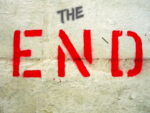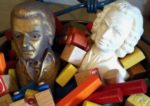Vintage PA: The Uncertainty Principle
 Remember my story wherein Teacher 42 became so uncomfortable with musical choices that she finally said, “You mean there’s no right way?” I concluded that I had given that teacher more doubt and uncertainty than she could handle. (PA Shorts: 42)
Remember my story wherein Teacher 42 became so uncomfortable with musical choices that she finally said, “You mean there’s no right way?” I concluded that I had given that teacher more doubt and uncertainty than she could handle. (PA Shorts: 42)
Well, I read an article, Helping Students Deal With Uncertainty In The Classroom, on Edutopia which went a long way toward explaining that reaction. In it, Ben Johnson discussed an educational experiment he did with a group of adult educators.
He asked the educators to form groups. Each person was to participate in four different groups and the composition of the groups were to be different. He did not give them any specifics on how this was to be accomplished.
Some of the adults were willing to work it out, trial and error even. Others would get to a point and then realize that they did not understand completely what to do and then would ask questions. A few even began getting upset at the lack of directions and were resistant.
Ben termed the experiment a failure but he learned much about the flexibility of thinking in that group of adults. He inferred that they and most of us can be divided into 3 groups: those comfortable with uncertainty, those uncomfortable with uncertainty, and those who are just plain irritated with uncertainty (i.e. “Teacher 42”).
Uncertainty is different: It is messy, it is disorganized, it is unstructured, and it is organic. When doubt exists and the answer or path is not known beforehand, that is the essence of uncertainty.
I am well known for saying learning is messy. Piano students make giant leaps at unexpected times and if you don’t notice and adjust the curriculum, you will have a very unhappy bored student. Complicating the messiness is the fact that the leaps often leave a student at different levels in performance, theory, technique, keyboard musicianship, etc.
Thank you Ben. I am vindicated. And, those who have looked at me in the past as though I had lobsters coming out of my ears need to get comfortable with a little doubt and uncertainty. Ben recommends that students get a daily dose of uncertainty to help them use what they know, find out what they don’t know, and figure out how to make it all work.
Unfortunately, we have socialized our students into the believing that not being certain is a bad thing, and as a result, few students are willing to take a risk and demonstrate their vulnerability.
We piano teachers need to help our students learn to deal with the uncertainty involved in approaching a new phrase of music, or encountering a new technique, or performing in front of an audience. At the same time we need help ourselves handle the uncertainness of teaching—spotting the great leaps, allowing gobs of time for a new concept or skill to blossom, managing our own irritations, fears, and doubts.
For myself, it is uncertainty that gives me the confidence to teach from the heart, to stand in a room full of colleagues and give a workshop, to write this blog. I know that I don’t and can’t possibly know everything in this vast musical world and I am strengthened and inspired by that very uncertainty.
After this post was written, in what I can only call a case of cosmic unity, Iron Chef judge Yefim Bronfman told Donatello Arpaio the following:
“I like the fact that you are confused because that is the sign of a true professional. I am confused when I play music all the time.”
Portions of this post were published in the summer of 2011



Yes, we all pick up on the perceived feelings of others, expressed openly or not. Thanks for the comment and thanks for reading.
Hi Gail! I was just thinking about a similar topic today; there’s a phenomenon we call Social Comparison Theory in psychology and it basically says that we evaluate ourselves (and adjust our behaviours) based on that of people around us. It’s definitely something to think about. If one person expresses their uncertainty, chances are, everyone will become uncertain and doubt themselves, even if they were certain before…